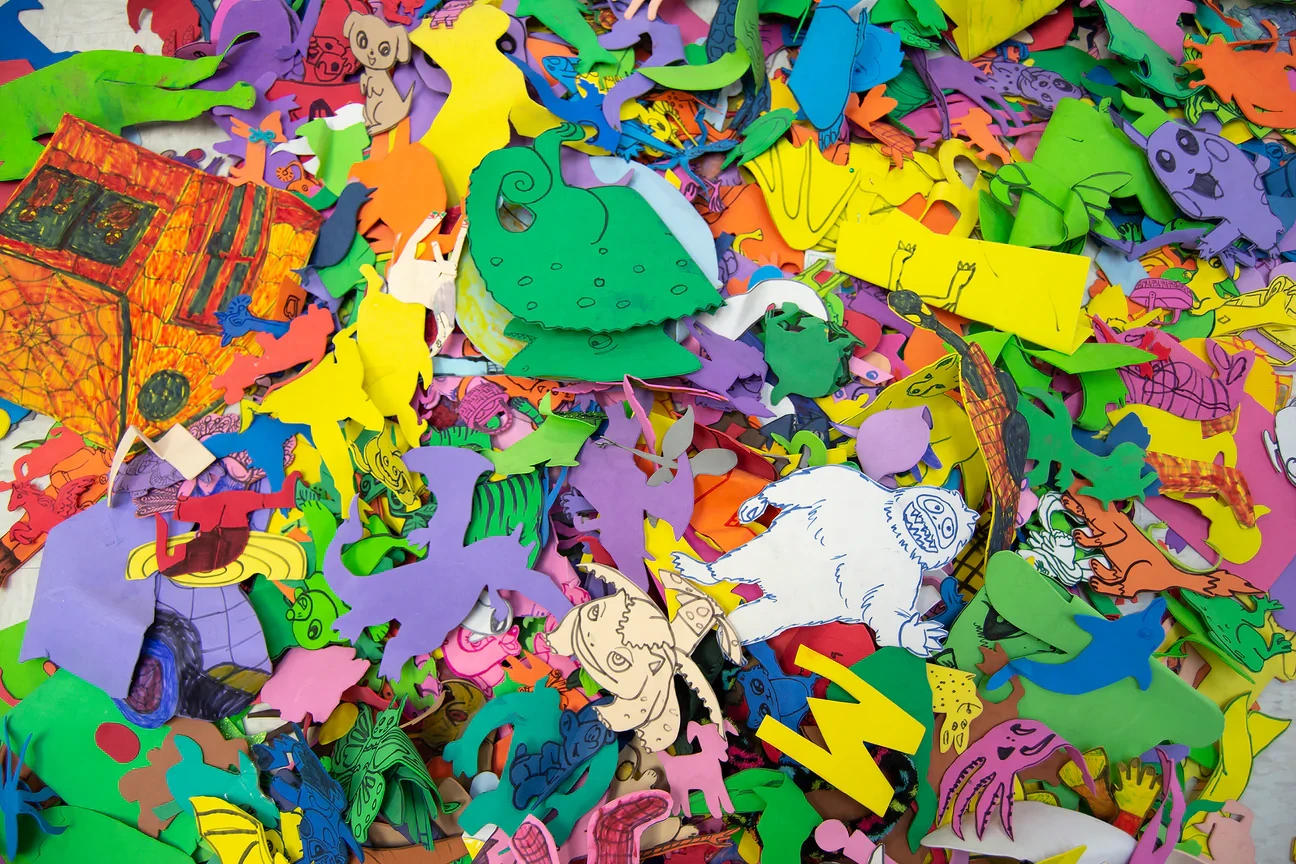Smith prefers the accessibility of drawing to more complicated mediums, but his drawings are anything but simple
Artist Casey Jex Smith has worked in nearly every medium — including performance, murals, sculpture and collage painting. But as he ages and assumes more responsibilities that infringe on his art-making time, he has chosen to focus on drawing.
“I like drawing because of its immediacy, meaning it’s really quick and clean to do,” Smith said. Contrast that with the work of his wife, Amanda Smith, who is a ceramicist and a relief painter. Her art requires clay, glazes and a kiln — all materials that demand space and time to set up. Similarly, painters need a studio and good ventilation, Casey Smith noted, and they have to stretch canvases. “All of these things are kind of deterrents to making art,” Smith said. “I do what I can to take away any difficulty to making. I can just grab a sketchpad, grab a pen and do my art.”
But this does not mean that Smith’s drawings are quick or simple; on the contrary, they are large and complex — encompassing whole civilizations and narratives with intricate detail — and often take months to create. The sheer amount of time spent on each of these drawings embeds into the work a weight or gravity that holds the viewer for a long time.

Fantasy, Belief and Power Inequalities
Prevalent themes throughout Smith’s work are fantasy, belief and power inequalities. In his own words: “I use the structures of role-play-gaming and religious ritual to create allegorical drawings. Leveling up, character creation, quest items, mythical beasts, and battles are used to mirror real life scenarios where the individual is manipulated, controlled, or squashed by a superior force. I contrast the reward system in gaming that is finely tuned to balance work with pleasure to the reward system of global capitalism that can feel arbitrary and cruel. My drawings are fantasy power simulations.” Visually, Smith draws inspiration from master etchings, “Dungeons & Dragons” manuals (particularly the early versions), isometric turn-based video games, scriptural narratives, “Where’s Waldo” illustrations and indie comics.
2016: A Year of Change & Autobiographical Art
The year 2016 was one of great change for Smith. It was the year he left his teaching job at a private school in Columbus, Ohio due to layoffs. At the suggestion of his sister-in-law, he completed a summer internship in user experience design at the cloud software company Domo in American Fork, Utah. At the end of the internship, Smith accepted a full-time position with Domo and moved with his family to Utah permanently. After a decade of working in art education, Smith said, “It felt like the death of being an artist.” All of these aspects of Smith’s life manifest in the autobiographical drawing “2016,” which took nearly the whole year to complete. He described the 38” x 58” piece as “very chaotic,” and said that at first there was no interest in exhibiting it. However, in the years since then it has been exhibited in “Periscope,” curated by Jimmy Viera at the Able Baker Contemporary in Portland, Maine, and at SPRING/BREAK Art Show in Los Angeles.

“That felt really good because it’s an awkward piece in a lot of ways, and I wasn’t quite sure what to make of it,” Smith said. “But it’s finally getting a good audience and great feedback.”
A Family Affair
Also included in the exhibition at SPRING/BREAK, curated by Professor Christopher Lynn, was a collaborative installation by Smith, his wife, and their two children, called “Foam Babies.” These foam cut-outs were created over a period of about five years, starting when Smith’s daughter, Gemma, did not want to go to preschool. “My wife made her a little character she could cut out,” Smith said. “It helped her cope with being [at school] and not feeling lonely. Gemma could ask Amanda to draw whatever she wanted. For a long time it was Pokémon. It was her favorite thing to ask us to draw stuff on the foam. At some point, [Gemma] started to draw her own and cut them out. Then our son started to ask for things.” The foam characters were exhibited in a pile between two walls displaying Casey’s and Amanda’s work. “We were very happy because any time there were small children, they would immediately jump in the pile and play," Smith said. "It was a very interactive piece."

Finding Balance
Since graduating from the art program at BYU almost 20 years ago, Smith has consistently made and exhibited artwork while also navigating the demands of work and a growing family. In his current career as a UX designer, he also utilizes aspects of his art training — most notably empathy and critical thinking. “The biggest thing is just a certain amount of criticality, to be able to look at something and deconstruct it,” Smith said. “Empathy is also a big thing in UX design. You need to have empathy for the user even though you’re not the user. As artists, you empathize with people, and you consume a lot of media that empathizes with people.” Smith and his wife — who met as graduate students in the Bay Area — now share an art studio in their home, where they work together in the evenings and take turns making art on the weekends. Smith stays active in the art world, curating shows and participating in exhibitions both within and outside of Utah.
